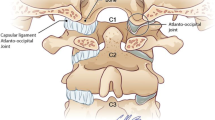Abstract
Background and purpose
Occipital condylar avulsion fractures are considered potentially unstable, associated with craniocervical dissociation spectrum injuries, and thought to carry a relatively high mortality rate based on the current literature. The purpose of this study was to identify patient with acute, occipital condylar avulsion fractures and evaluate for the incidence of concomitant cervical osteoligamentous trauma and craniocervical dissociation spectrum injury on cervical spine CT and MRI.
Materials and methods
Patients who suffered an inferomedial occipital condylar avulsion fracture were identified retrospectively using Nuance mPower software. Cervical spine CT and MRI reports performed within 48 h for this patient cohort were then reviewed by two CAQ certified neuroradiologists. Confirmation of an occipital condylar avulsion fracture was recorded along with any concomitant craniocervical junction injury. Relevant clinical history, including management and outcomes, was recorded for each patient.
Results
Thirty-four patients were identified with an inferomedial fracture of the occipital condyle. Of the 85% of patients who underwent cervical MRI, all but one patient demonstrated a ‘negative’ MRI without major craniocervical junction ligamentous injury. These patients were treated conservatively with external bracing without persistent neurologic deficits upon 4-month follow-up.
Conclusions
Inferomedial fractures of the occipital condyle are currently classified as potentially unstable fractures based on the Anderson classification system. Our data suggest that an isolated occipital condylar avulsion fracture without an additional C1–C2 fracture or widening of the atlanto-occipital joint space is likely a stable injury that can be treated conservatively with excellent clinical outcomes.




Similar content being viewed by others
References
Offiah CE, Day E (2017) The craniocervical junction: embryology, anatomy, biomechanics and imaging in blunt trauma. Insights Imaging 8:29–47. https://doi.org/10.1007/s13244-016-0530-5
Menezes A, Traynelis V (2008) Anatomy and biomechanics of normal craniovertebral junction (a) and biomechanics of stabilization (b). Child’s Nerv Syst 24:1091–1100
Tubbs RS, Hallock JD, Radcliff V, Naftel RP, Mortazavi M, Shoja MM, Loukas M, Cohen-Gadol AA (2011) Ligaments of the craniocervical junction. J Neurosurg Spine 14(6):697–709. https://doi.org/10.3171/2011.1.SPINE10612
Iwanaga J, Sardi J, Voin V, Chapman JR, Oskouian RJ, Tubbs RS et al (2017) Anatomy of alar ligament part I: morphometrics and variants. World Neurosurg 107:1001–1006
Riascos R, Bonfante E, Cotes C, Guirguis M, Hakimelahi R, West C (2015) Imaging of atlanto-occipital and atlantoaxial traumatic injuries: what the radiologist needs to know. Radiographics 35(7):2121–2134. https://doi.org/10.1148/rg.2015150035
Anderson PA, Montesano PX (1988) Morphology and treatment of occipital condyle fractures. Spine (Phila Pa 1976) 13(7):731–736. https://doi.org/10.1097/00007632-198807000-00004
Osmotherly PG, Rivett DA, Mercer SR (2013) Revisiting the clinical anatomy of the alar ligaments. Eur Spine J 22(1):60–64. https://doi.org/10.1007/s00586-012-2496-4
Sunar M, Kapakin S (2019) Morphometric evaluation of craniocervical junction by magnetic resonance imaging method. Asian J Neurosurg 14(3):702–709. https://doi.org/10.4103/ajns.AJNS_293_17
Nidecker AE, Shen PY (2016) Magnetic resonance imaging of the craniovertebral junction ligaments: normal anatomy and traumatic injury. J Neurol Surg B Skull Base 77(5):388–395. https://doi.org/10.1055/s-0036-1584230
Siddiqui J, Grover PJ, Makalanda HL et al (2017) The spectrum of traumatic injuries at the craniocervical junction: a review of imaging findings and management. Emerg Radiol 24:377–385. https://doi.org/10.1007/s10140-017-1490-x
Deliganis AV, Baxter AB, Hanson JA, Fisher DJ, Cohen WA, Wilson AJ et al (2000) Radiologic spectrum of craniocervical distraction injuries. Radiographics 20:S237–S250
Chang YM, Kim G, Peri N, Papavassiliou E, Rojas R, Bhadelia RA (2017) Diagnostic utility of increased STIR signal in the posterior atlanto-occipital and atlantoaxial membrane complex on MRI in acute C1–C2 fracture. AJNR Am J Neuroradiol 38(9):1820–1825. https://doi.org/10.3174/ajnr.A5284
Tuli S, Tator CH, Fehlings MG, Mackay M (1997) Occipital condyle fractures. Neurosurgery 41(2):368–376. https://doi.org/10.1097/00006123-199708000-00006
Hanson JA, Deliganis AV, Baxter AB, Cohen WA, Linnau KF, Wilson AJ, Mann FA (2002) Am J Roentgenol 178(5):1261–1268
Gire JD, Roberto RF, Bobinski M, Klineberg EO, Durbin-Johnson B (2013) The utility and accuracy of computed tomography in the diagnosis of occipitocervical dissociation. Spine J 13:510–519. https://doi.org/10.1016/j.spinee.2013.01.023
Dahdaleh NS, Khanna R, Menezes AH et al (2016) The application of the revised condyle-C1 interval method to diagnose traumatic atlanto-occipital dissociation in adults. Global Spine J 6:529–534. https://doi.org/10.1055/s-0035-1569058
Hadley MN, Walters BC, Grabb PA, Oyesiku NM, Przybylski GJ, Resnick DK, Ryken TC, Mielke DH (2002) Guidelines for the management of acute cervical spine and spinal cord injuries. Clin Neurosurg 49:407–498
Hall GC, Kinsman MJ, Nazar RG et al (2015) Atlanto-occipital dislocation. World J Orthop 6(2):236–243. https://doi.org/10.5312/wjo.v6.i2.236
Kukreja S, Ambekar S, Sin AH, Nanda A (2015) Occipitocervical Fusion Surgery: Review of Operative Techniques and Results. J Neurol Surg B Skull Base 76(5):331–339. https://doi.org/10.1055/s-0034-1543967
Kwong Y, Rao N, Latief K (2011) Craniometric measurements in the assessment of craniovertebral settling: are they still relevant in the age of cross-sectional imaging?. AJR Am J Roentgenol. 196 (4): W421-
Smith P, Linscott LL, Vadivelu S, et al (2015) Normal development and measurements of the occipital condyle-C1 interval in children and young adults. AJNR Am J Neuroradiol Oct 29. [Epub ahead of print] doi:https://doi.org/10.3174/ajnr.A4543 pmid:26514612
Pang D, Nemzek WR, Zovickian J (2007) Atlanto-occipital dislocation, part 2: the clinical use of (occipital) condyle-C1 interval, comparison with other diagnostic methods, and the manifestation, management, and outcome of atlanto-occipital dislocation in children. Neurosurgery 61:995–1015. doi:https://doi.org/10.1227/01.neu.0000303196.87672.78
Author information
Authors and Affiliations
Corresponding author
Ethics declarations
Conflict of interest
The authors declare that they have no conflict of interest.
Additional information
Publisher's Note
Springer Nature remains neutral with regard to jurisdictional claims in published maps and institutional affiliations.
Rights and permissions
About this article
Cite this article
Fiester, P., Rao, D., Soule, E. et al. Occipital condylar avulsion fractures in the acute trauma setting: Stable or unstable injury?. Eur Spine J 30, 3128–3134 (2021). https://doi.org/10.1007/s00586-021-06949-3
Received:
Revised:
Accepted:
Published:
Issue Date:
DOI: https://doi.org/10.1007/s00586-021-06949-3




